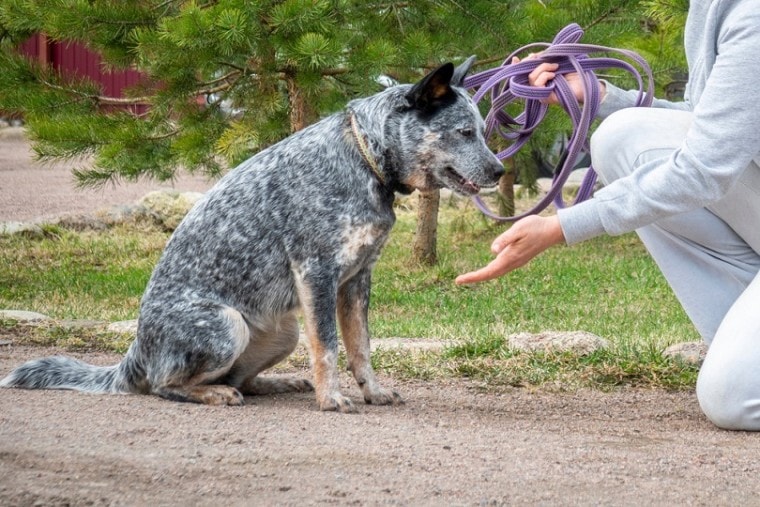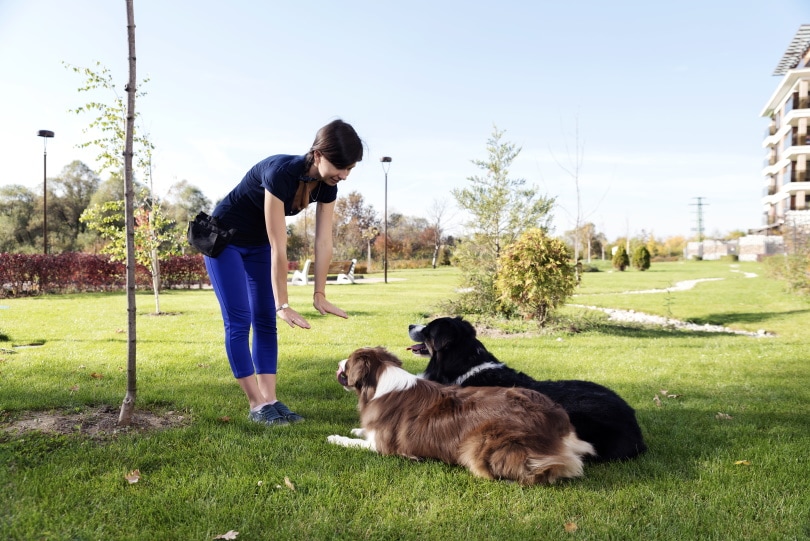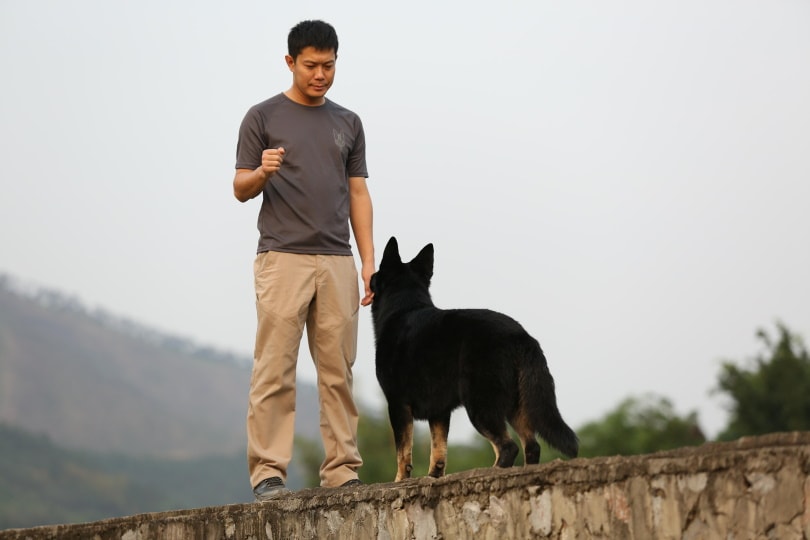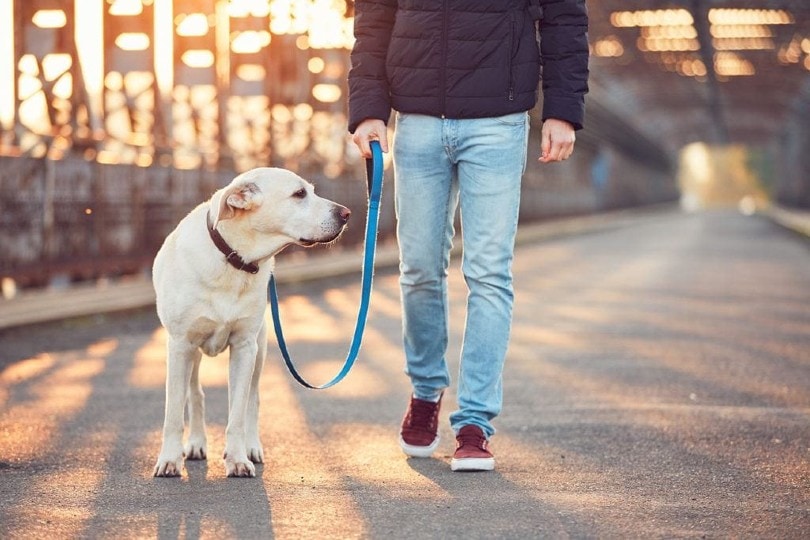
Do you have a new puppy and no idea where to start with puppy training? Is your adult dog ignoring every word you say and you are desperate to find a solution? No matter their age or ability, dogs can always benefit from learning basic commands. Having a well-behaved dog will make your life easier as well. Many dog owners choose to take their dogs to training classes or hire a trainer. However, with a lot of patience and plenty of treats, you can certainly teach your dog basic obedience yourself.
Here are some tips for teaching basic commands as well as some general guidelines for how to be successful in training your dog.
Tips For Successful Dog Training
Whether your dog is just getting started with training or brushing up on advanced skills, there are some general steps you can take to get the most out of your training session:

Tips For Teaching Some Basic Dog Commands
You have your pocket full of treats, you’re in a quiet room, and your dog is just the right amount of tired: now where to begin? What commands should you start with and how should you teach them? While dogs are capable of learning a lot, basic obedience focuses on keeping your dog safe and under your control, allowing them to be a more enjoyable companion.
The basis of positive reinforcement training is to reward the desired behavior as soon as your dog performs it, then connect the behavior with the spoken command.
The 5 Basic Commands to Teach Your Dog
1. Sit

Teaching your dog to sit is the basis for most other obedience work. It also tends to be one of the simpler commands for your dog to learn.
To teach your dog to sit, have them start out facing you. Get their attention with a treat and move the treat back over their head as a lure. As the dog naturally follows the movement of the treat, their rear will make contact with the ground. As soon as that happens, reward them!
Continue to reward your dog for the sitting behavior and then introduce the spoken command, “sit” as your dog begins to understand what you want them to do. Be patient and consistent until your dog will sit reliably on command.
Once your dog knows how to sit, you can have them practice throughout the day by asking them to sit before you feed them or put them on their leash.
Never try to force your dog into a sitting position to teach this command. Again, the goal is for your dog to have a positive experience and want to work with you willingly.
2. Come (Recall)

To teach this command, stand a few steps away from your dog, get down to their level and lure them towards you with a treat and lots of enthusiasm. Reward your dog when they come to you. Gradually increase the distance between you and your dog and continue to reward them when they come to you.
As your dog learns they will be rewarded for coming to you, start to connect the command to “come” with the behavior. Say your dog’s name, followed by the command and praise and reward profusely when your dog obeys. As your dog gets better at following this command, start introducing distractions by practicing with other people or outside.
Part of teaching your dog to reliably come when called is always making sure your dog has a positive experience when they come to you. Don’t call your dog to you in order to scold them or for another negative reason.
3. Down

Down is easiest to teach once your dog has mastered sitting on command. Ask your dog to sit and then get their attention with a treat. Move the treat down towards the floor to lure your dog into lying down. As soon as your dog moves into a lying-down position, reward them!
Practice this movement until your dog understands they will be rewarded when they lie down. Now you can begin to say the command “down” as your dog performs the behavior.
Avoid forcing your dog into a down position as you teach this command. Again, you want your dog to do what you ask because they want to please you, not because they fear you.
4. Stay

Like lying down, the stay command is easiest to teach after your dog has learned to sit on command. Ask your dog to sit, hold your hand in front of their face, and then take a step back. If your dog gets up to follow you, repeat the process. If your dog remains in place when you move away, reward them!
Practice this process and start saying the verbal command “Stay!” as your dog starts to understand the behavior you are asking for. As your dog gets better at this task, you can start asking them to stay for longer times or moving farther away.
The goal is to get your dog to stay in place until you give the okay. Eventually, you will want to teach your dog to stay despite the presence of distractions like other dogs and people.
5. Heel

Teaching your dog to heel essentially just means teaching them to walk beside you on a loose leash. We’ve all seen or even been the person being dragged down the sidewalk by their excited dog. It’s no fun and can be dangerous. Avoid this by teaching your dog how to heel.
With your dog on a leash, have them sit beside you and be prepared with treats. Begin walking with your dog and feed treats to reward them for staying beside you. If your dog begins to pull or moves ahead of you, stop walking. Don’t jerk the leash or scold them. Lure them back to your side with treats and begin the process again.
The idea is for your dog to learn that walking at heel results in treats and praise while pulling means we stop moving altogether, plus no treats. Teaching your dog to heel may take some patience but the results will be worth it.
Avoid using choke or training collars on your dog as you teach them to heel. These can be painful and again, defeat the purpose of positive training.
What to Do If Your Dog Ignores All These Tips
You’ve been patient, you’ve practiced, you’ve fed so many treats they’re coming out your dog’s ears but they just don’t seem to be getting the hang of the basic commands. Now what?
Just like people, dogs have different personalities and different learning styles. The tips in this article are basic guidelines that give you a good place to start when training your dog. Some dogs may take more time to learn or may need more creativity in their training regimen.
If you’re finding that you and your dog are struggling with training, don’t despair! There are many resources available to help both of you.
A good place to start is talking with your veterinarian. Veterinarians don’t just take care of your dog’s health needs, they can assist with behavior and training concerns as well. Many veterinary clinics offer training classes or can recommend good ones if you want to go that route.
Plenty of dog training books and online resources are available to you as well. Dog training is not a one-size-fits-all situation, and you may have to try different methods to find the best way to teach your dog.
If you do decide to enlist a trainer or enroll in training classes, try to find one that uses positive or fear-free training methods.
- You may want to read this next: How to Teach Your Dog to Lie Down: 3 Easy Methods
Conclusion
Teaching your dog basic commands is a great way to build a relationship with them, as well as help them become a more enjoyable member of the family. By the way, the tips we discussed are just the tip of the iceberg when it comes to what your dog can learn. Maybe you want your dog to pick up some awesome tricks to impress your friends, or perhaps you love the idea of your dog becoming a therapy dog. Love dancing and love your dog? There’s a sport for you too! Once your dog learns basic commands, the sky (or maybe your dog treat budget) is the limit for where you go from there. Of course, if all you want is for your dog to consistently listen to what you ask, that’s okay too.
- Mastered the basics? Why not give Agility Pause Table Dog Training or Weave Poles Agility Training a try!
Featured Image Credit: lara-sh, Shutterstock







